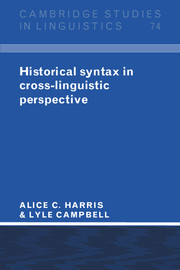Book contents
- Frontmatter
- Contents
- Preface
- List of abbreviations
- 1 Introduction
- 2 The history of historical syntax: major themes
- 3 Overview of a theory of syntactic change
- 4 Reanalysis
- 5 Extension
- 6 Language contact and syntactic borrowing
- 7 Processes that simplify biclausal structures
- 8 Word order
- 9 Alignment
- 10 On the development of complex constructions
- 11 The nature of syntactic change and the issue of causation
- 12 Reconstruction of syntax
- Appendix
- Notes
- References
- Index of languages and language families
- Index of scholars
- Index of subjects
2 - The history of historical syntax: major themes
Published online by Cambridge University Press: 05 June 2012
- Frontmatter
- Contents
- Preface
- List of abbreviations
- 1 Introduction
- 2 The history of historical syntax: major themes
- 3 Overview of a theory of syntactic change
- 4 Reanalysis
- 5 Extension
- 6 Language contact and syntactic borrowing
- 7 Processes that simplify biclausal structures
- 8 Word order
- 9 Alignment
- 10 On the development of complex constructions
- 11 The nature of syntactic change and the issue of causation
- 12 Reconstruction of syntax
- Appendix
- Notes
- References
- Index of languages and language families
- Index of scholars
- Index of subjects
Summary
Introduction
The long history of the study of syntactic change is characterized not by major breaks in tradition, but by a few persistent themes. Most recent claims are not new, but were anticipated in the past and are the continuation of lines of thought which have endured in the history of linguistics. This view of the history of diachronic syntax contrasts sharply with that held by some scholars today: for example, Lightfoot argues that little insightful work on syntactic change was achieved in the past (197a: 7–41; 1988a: 305–7). We disagree with his interpretation of linguistic history; as will be seen, it is not the case that “the nineteenth-century [and earlier] linguists … made no attempt to posit general principles of syntactic change,” nor that “certainly there was no tradition of work on syntactic change, and, despite isolated discussions, it was not until the 1970s that syntactic change became an area of communal work among linguists” (Lightfoot 1988a: 305). While Lightfoot has articulated this view clearly, numerous other contemporary practitioners of diachronic syntax imply in their work that they hold a similar view.
- Type
- Chapter
- Information
- Historical Syntax in Cross-Linguistic Perspective , pp. 14 - 47Publisher: Cambridge University PressPrint publication year: 1995

